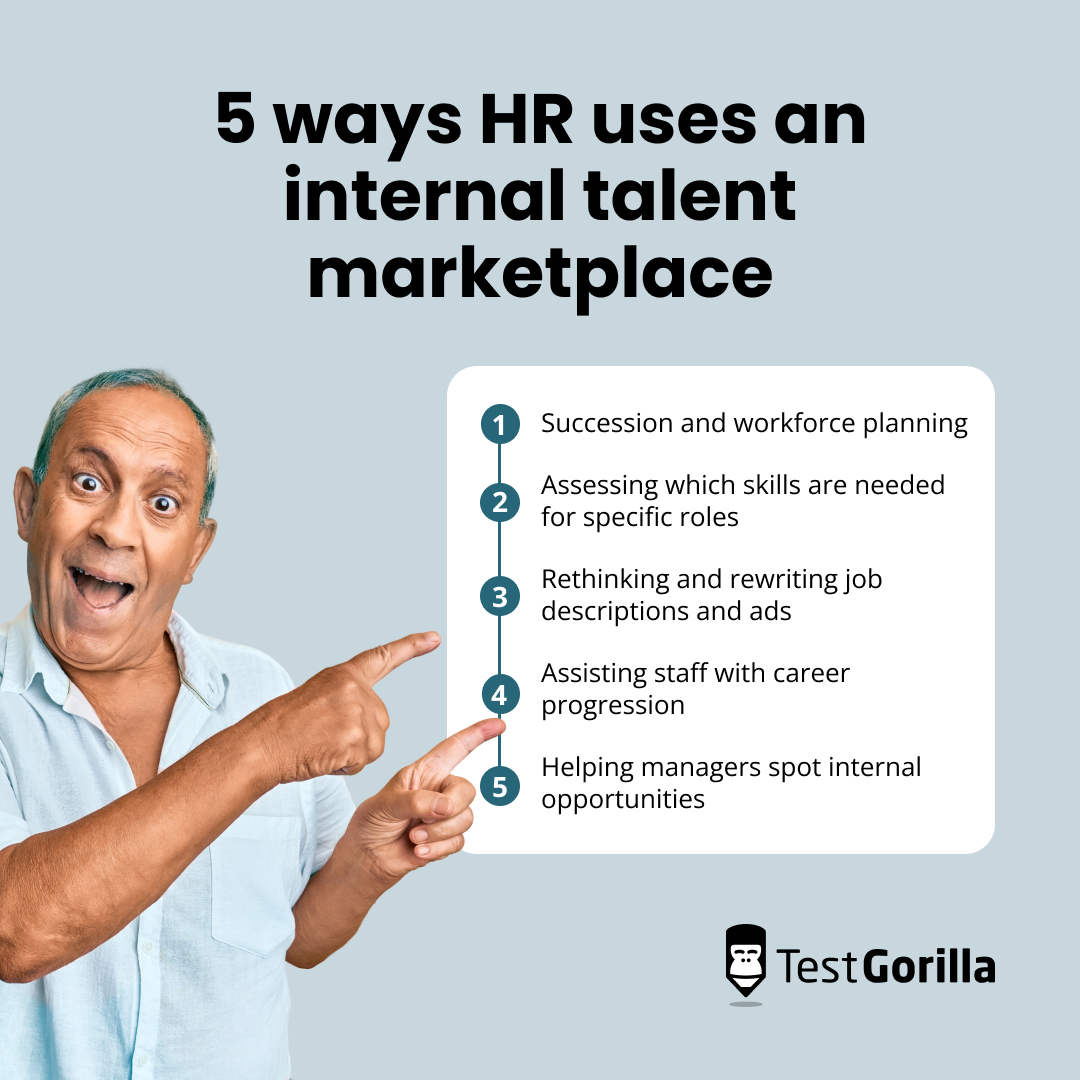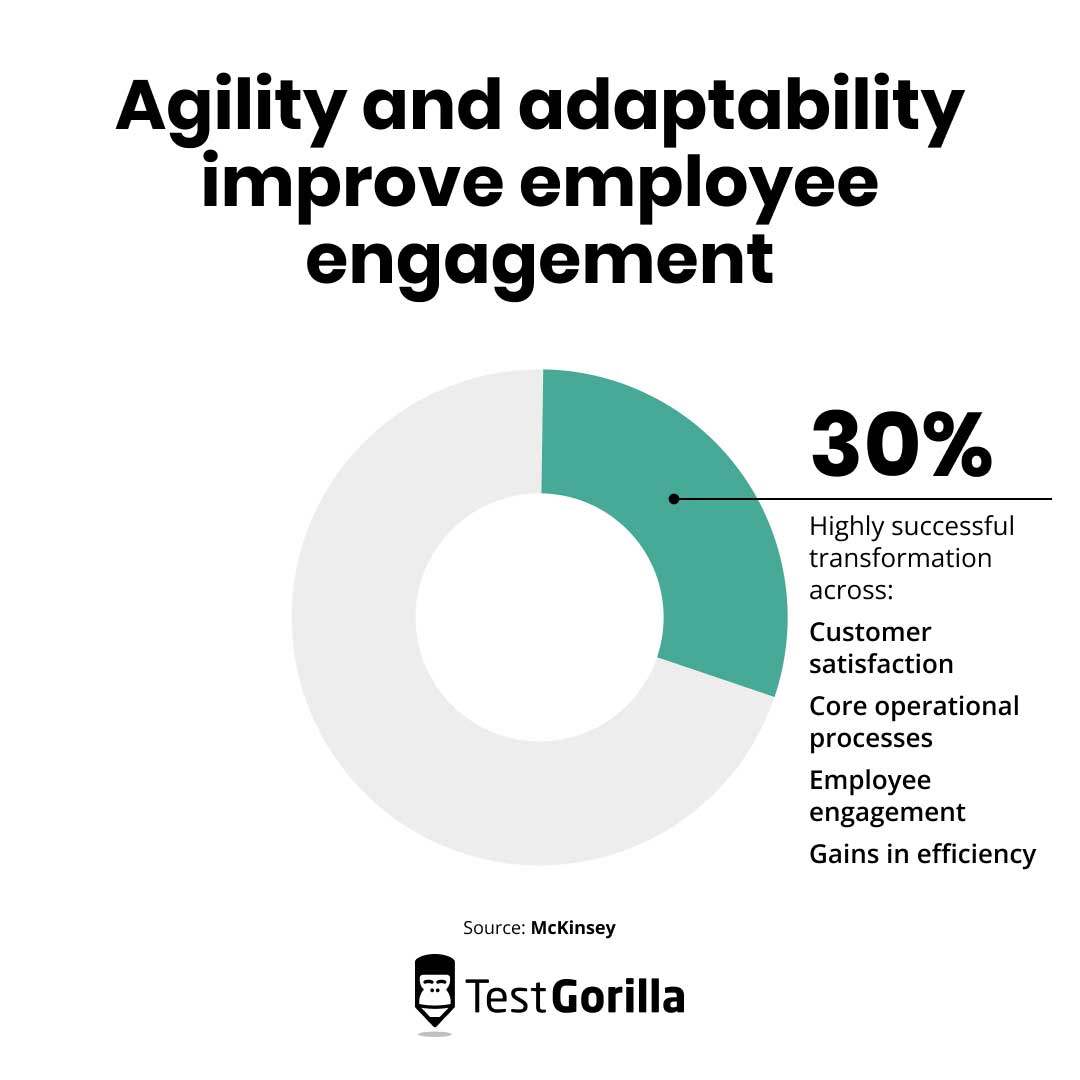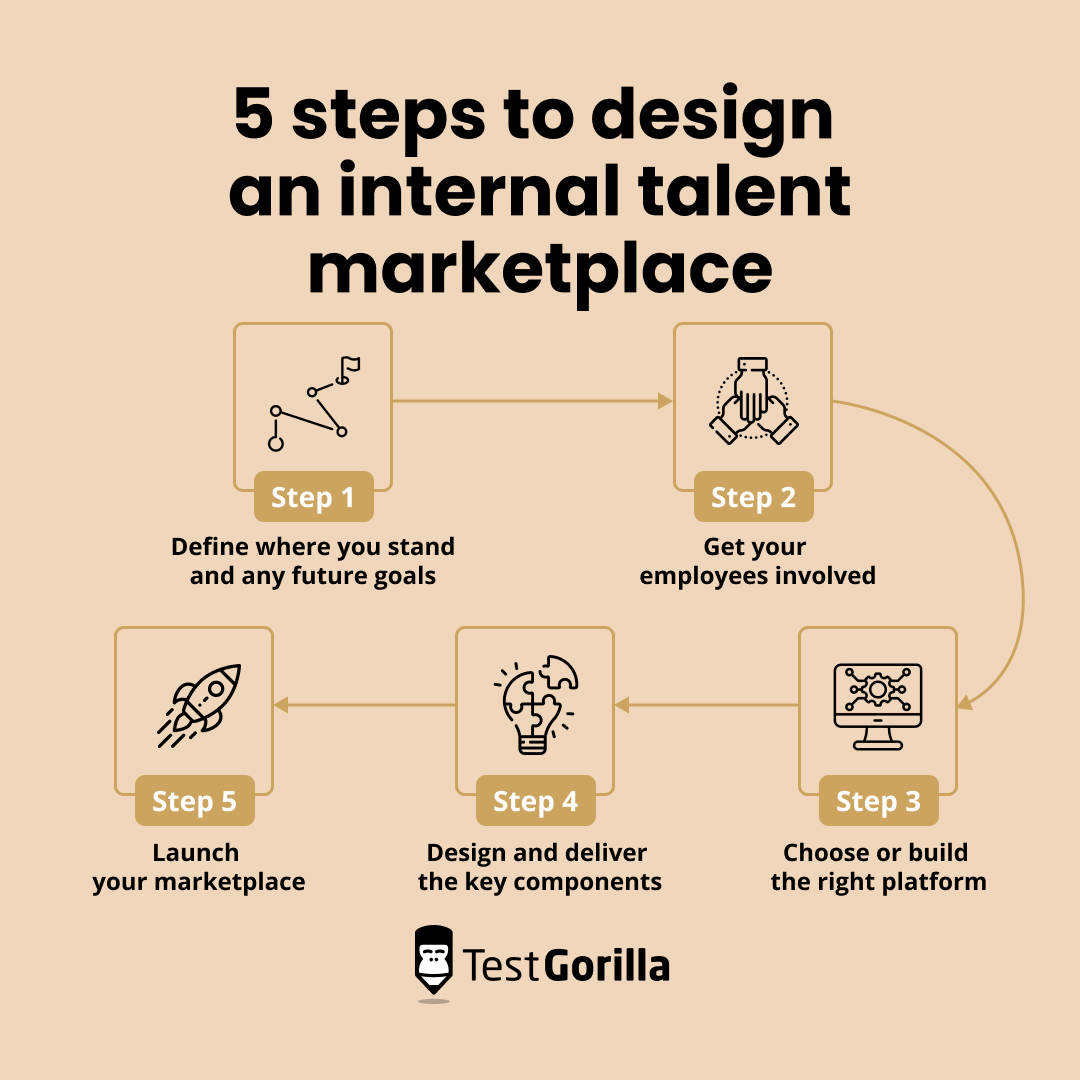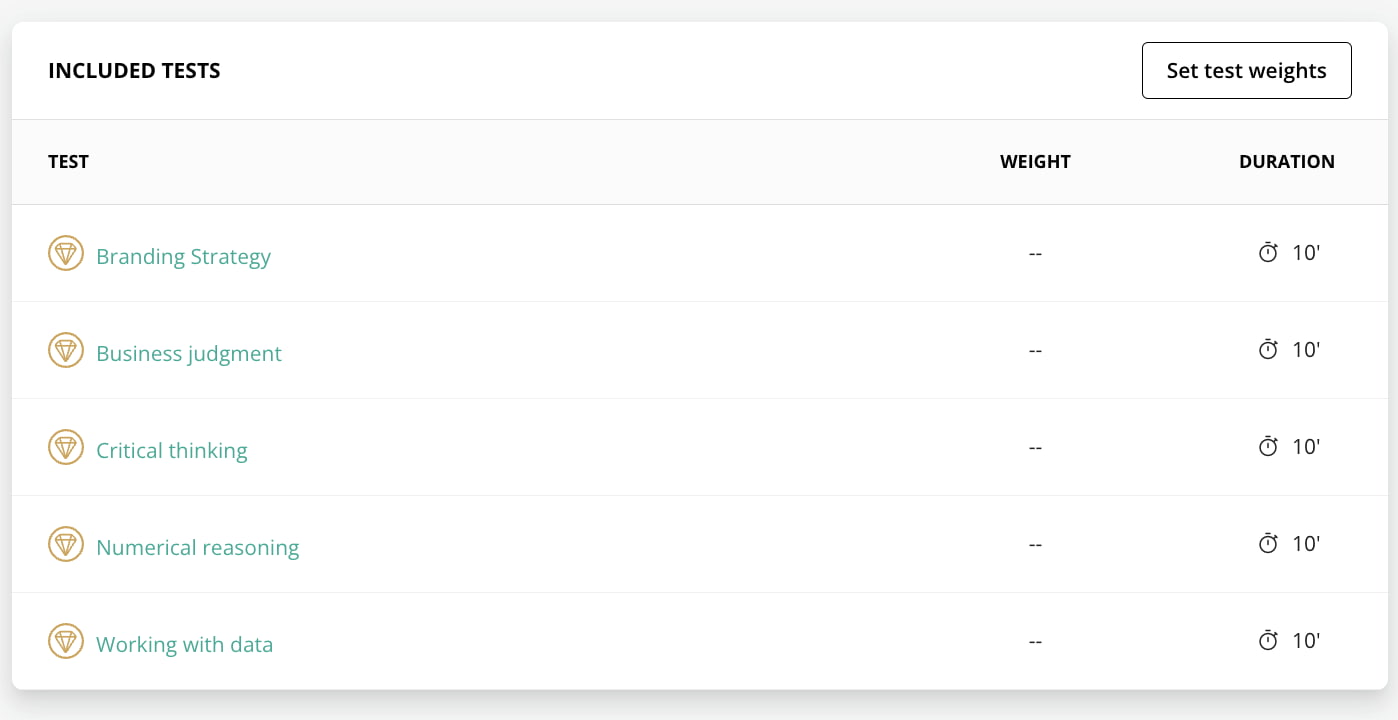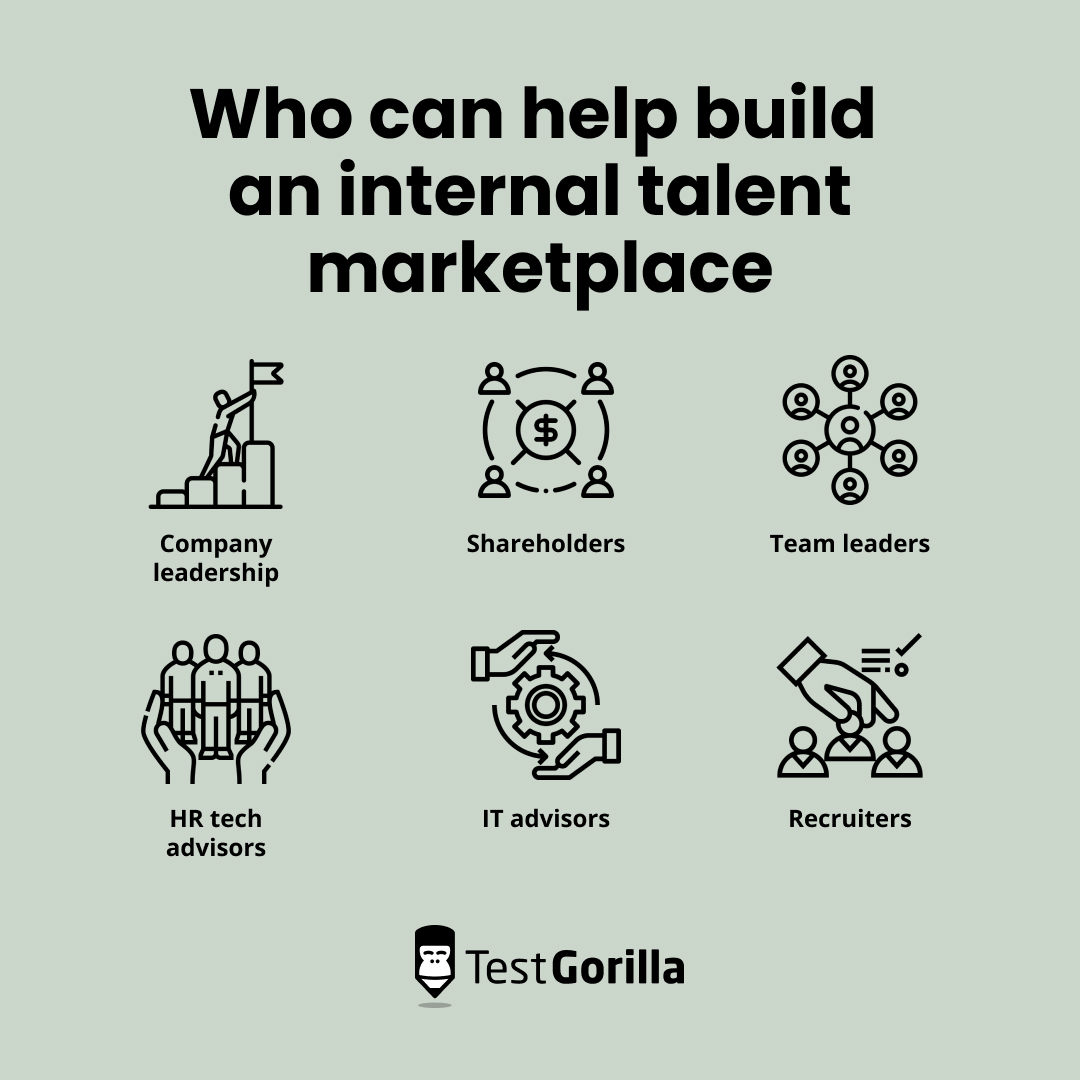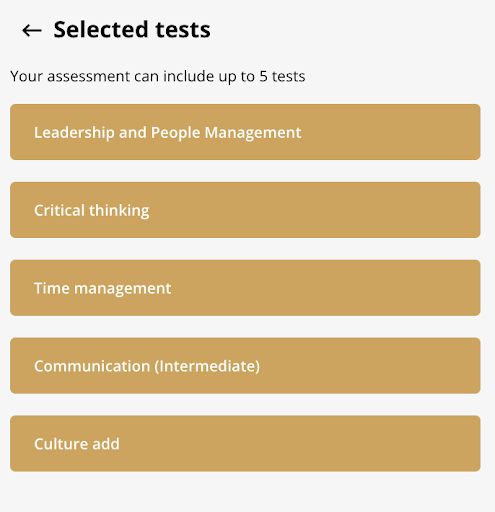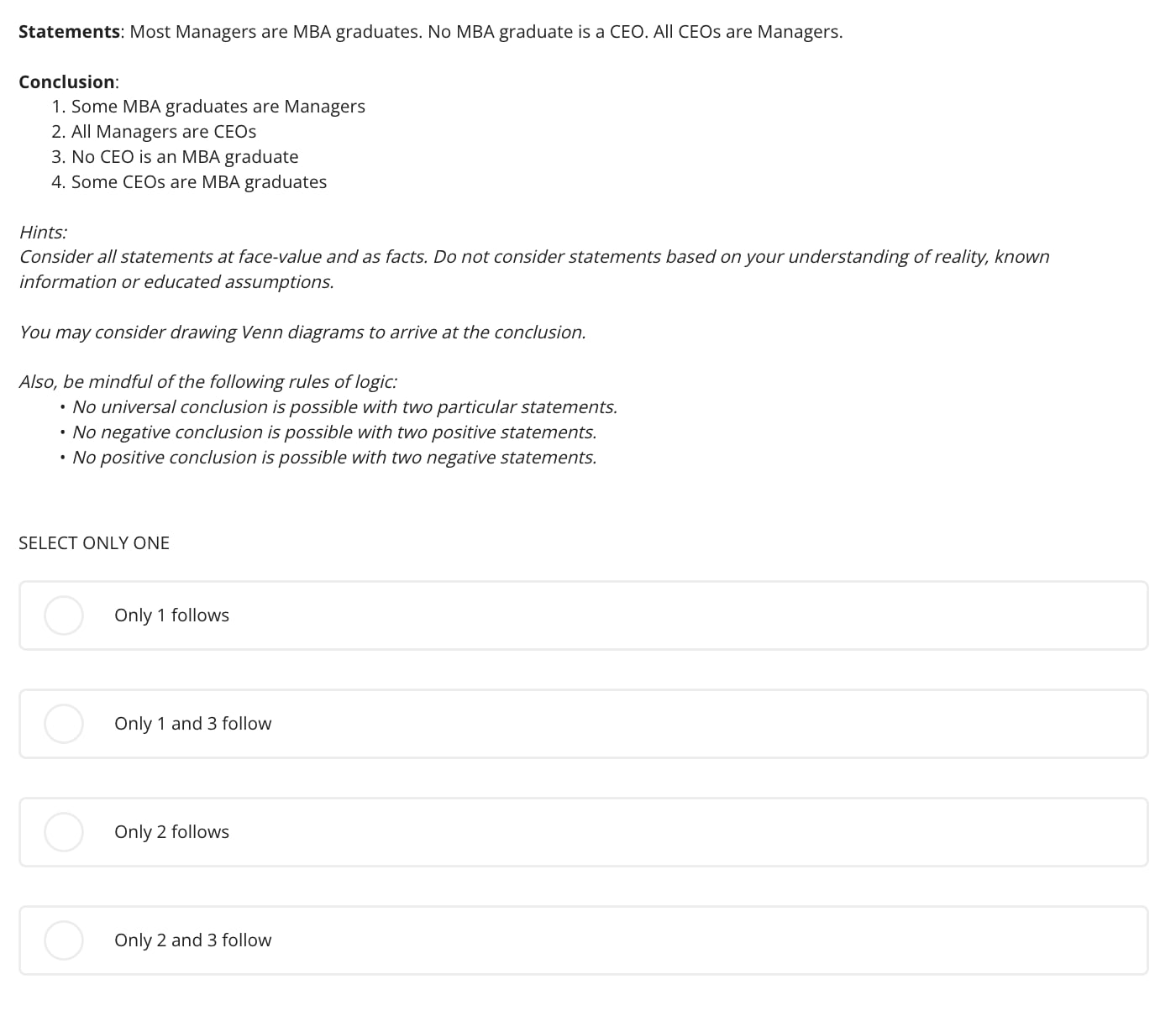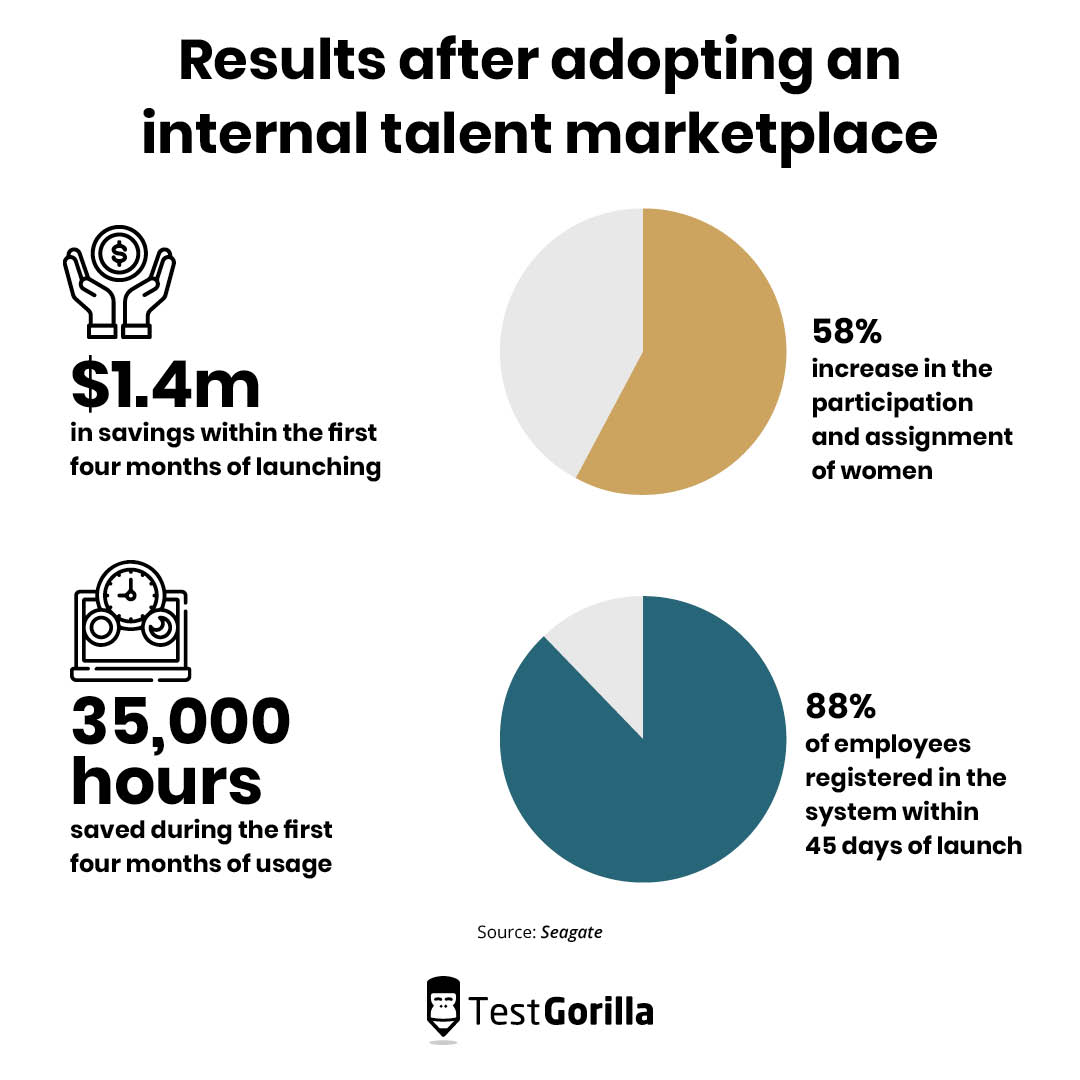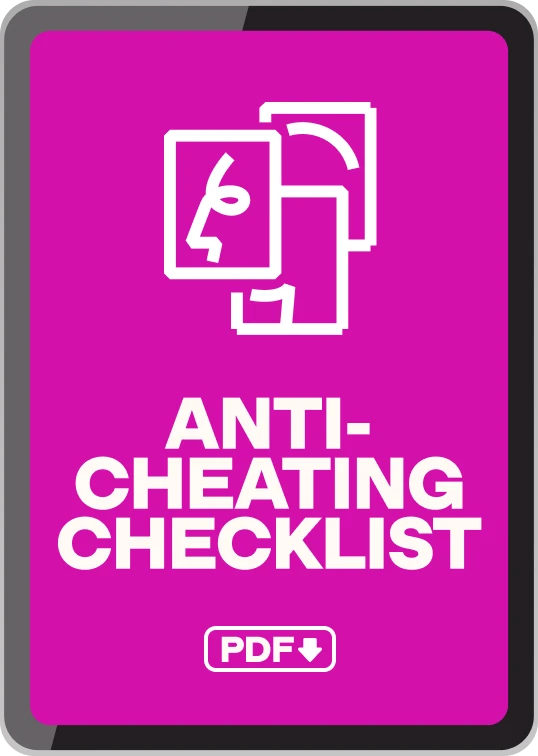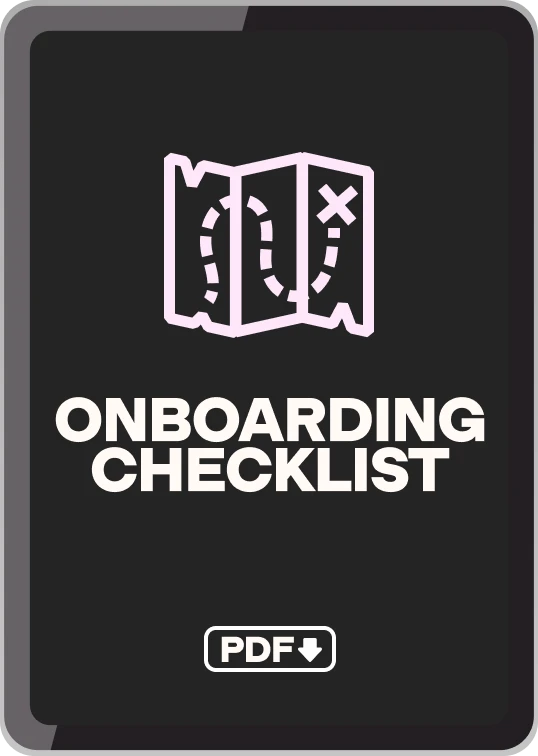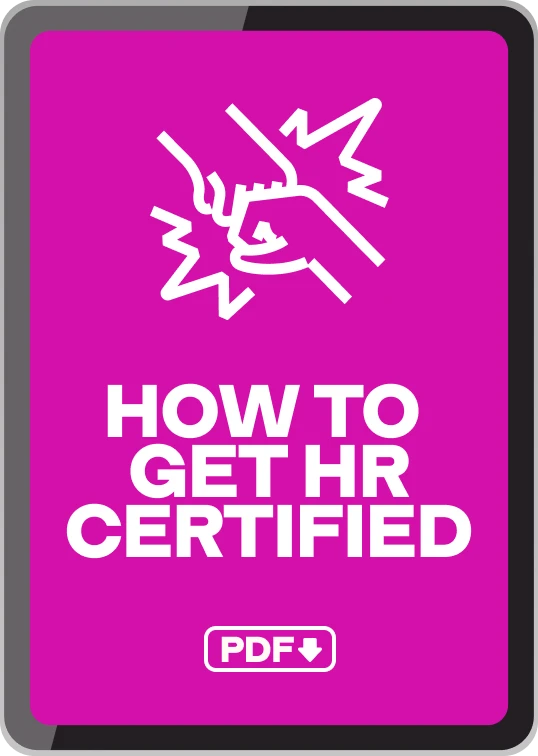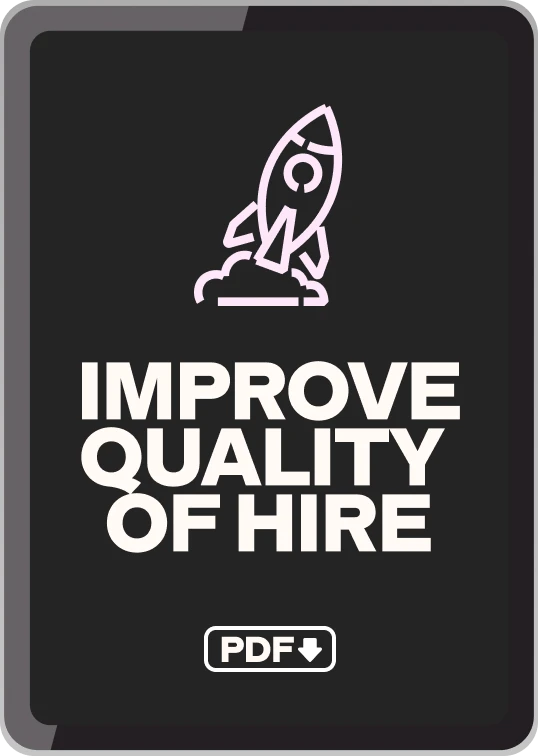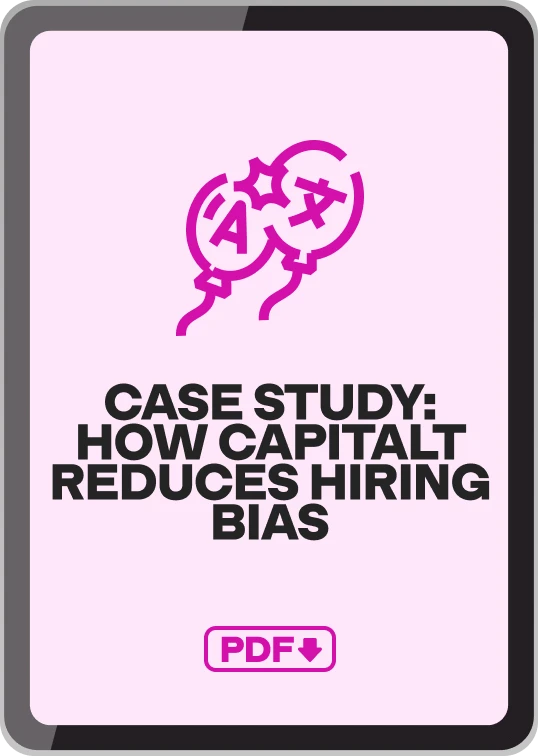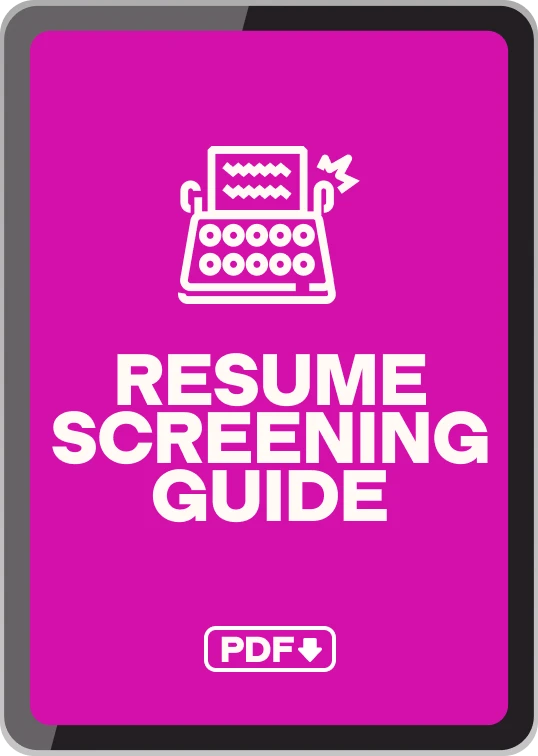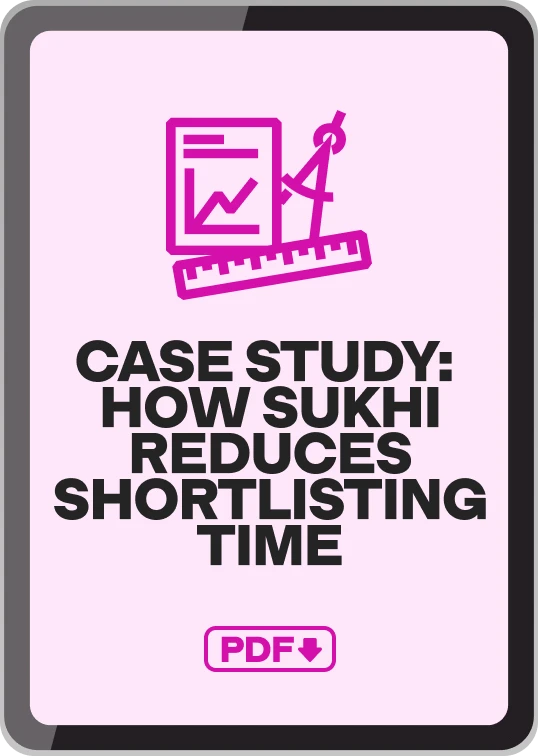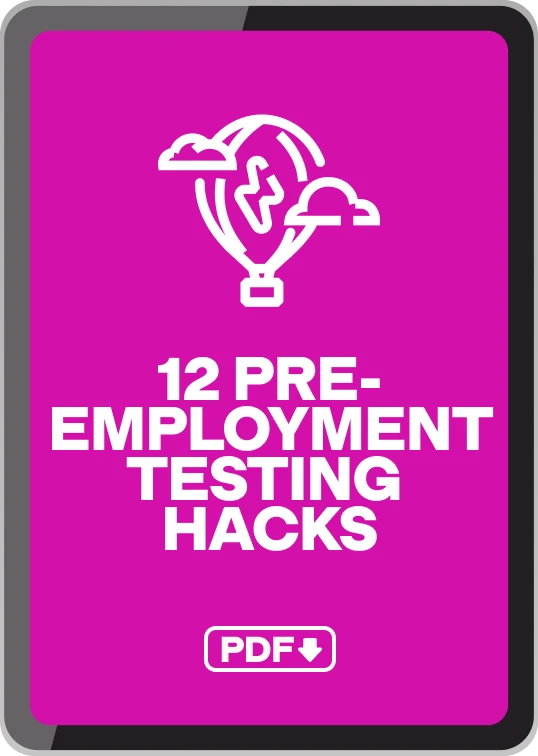Internal talent marketplaces: Leverage this retention strategy and keep employees engaged
The struggle to recruit employees and retain existing personnel can be frustrating and exhausting. During the Great Resignation, hiring manager workloads increased by 45%.[1]
This is happening because businesses need a consistent flow of talent to fill roles and bridge skill gaps – a common concern for 90% of companies.[2]
What’s more, you also have to engage current employees to help them reach their full potential. Otherwise, you risk your employee turnover rate increasing.
What if you could solve both issues at once? With an internal talent marketplace, you can.
Internal recruiting is a system that helps an organization fill positions with current employees – you’re using motivated talent right under your nose while supporting existing workers with new opportunities.
Below, we explore this game-changing talent retention strategy and how you can start an internal talent marketplace from scratch.
Table of contents
- What is an internal talent marketplace?
- Why are internal talent marketplaces important?
- The benefits of an internal talent marketplace
- How to design an internal talent marketplace: 5 steps
- 6 best practices for leveraging talent marketplaces to retain your best performers
- 3 examples of companies succeeding with an internal talent marketplace as a talent retention strategy
- Build an internal talent marketplace and keep your best employees in circulation
What is an internal talent marketplace?
An internal talent marketplace is a central platform where employers list open positions, and workers share their skills to find role matches.
It's an engaging way to offer internal opportunities and teach new skills. Given that around 63% of people leave employers thanks to a lack of advancement, this accessible path for employee development is an effective method of retention.[3]
Human resources and upper management can use software to find suitable internal candidates and match them to full-time roles without having to recruit from scratch.
What’s more, using marketplaces can help employers leverage emerging talent retention trends more easily.
For example, it's easy for managers to support employee job rotations through a marketplace, thus giving people more variety and filling gaps ad hoc.
What are the main features of talent marketplace platforms?
An internal talent mobility platform typically supports the following HR capabilities:
Succession planning – to ensure there’s always talent available to step into roles if employees vacate
Mentoring – to match experienced workers to recruits who want development opportunities
Career pathing – to help people find different career paths and offer advice on how to manage them
However, this list is by no means exhaustive:
Why are internal talent marketplaces important?
Internal talent marketplaces tell you who in your company is looking for new opportunities and what skills they possess.
You can then use this data to match employee profiles to open roles that you’d typically have to spend time and money recruiting for. This HR technology helps you realize and achieve the full potential of your workforce.
Moreover, this sort of talent management system matches employees based on competencies and interests rather than experience and superficial attributes, which makes for a more inclusive culture.
With smart skills matching, marketplaces nudge workers toward their goals and the career paths they might be ideally suited for. Therefore, people unsure of what steps to take next can gain clarity on where they want to progress.
Beyond this, talent marketplaces help managers move employees quicker and easier between roles. For instance, they might use AI-powered workforce planning to cut out unnecessary admin.
Ultimately, employers expect a more adaptable and agile workforce – and an internal marketplace enables employees to shift from role to role with increased agility.
Given only 22% of people believe their companies are good at internal career mobility, this is an edge worth pursuing.[4]
With adaptability, you can leverage multipotentialites and expert generalists to move between multiple tasks instead of securing specific people to formal job roles.
The benefits of an internal talent marketplace
When running an efficient and supportive internal talent marketplace initiative:
Retention increases
Costs reduce
Agility and adaptability improve
Organizational silos break down easier
Let’s explore these benefits in more detail.
Retention increases
If an employee doesn’t see a promising future with you, they might find it elsewhere. This is unfortunate because many employees would rather develop where they are than quit to look elsewhere.
Yet, barely 25% of employees feel confident about their career development at their present companies.
Moreover, in the US alone, 48% of workers are ready to leave their jobs if better career growth opportunities are on the table elsewhere.[5]
Companies with reliable internal mobility programs retain employees for nearly twice as long as the average.[6]
Talent marketplaces specifically help to retain workers who are considering leaving purely for more interesting opportunities.
You might expect your employee attrition rates to decrease, provided you manage a marketplace effectively. Research shows that 61% of people are “very likely” to stay with their employer if upskilling opportunities are available.[5]
Costs reduce
A shorter internal hiring process means less money spent on hiring, onboarding, and training. There are long-term savings from reduced turnover, too.
The average cost of hiring a recruit is more than $4,600. That's $500,000 spent on 108 recruits across a year, not accounting for the additional costs of a bad hire.[7]
Using internal talent to fill these skill gaps and open roles saves you up to 20% of the cost per hire, with marketplace software, systemic restructuring, and ongoing training to consider.[8]
Agility and adaptability improve
Agile businesses respond faster to crises and emerging industry trends by quickly aligning the best talent to suitable roles, something smart internal marketplaces do for you by default.
Businesses undergoing agile transformations experience a 30% increase in employee engagement, efficiency, and operational quality:
Moreover, studies suggest there are reductions in operational costs of around 20%-30% due to becoming more agile.[9]
Marketplaces encourage greater employee engagement and adaptability because they are skills-focused. For example, two job titles in two completely different departments might trigger a match for one employee with provable project management skills.
It's easier, therefore, for managers to move adaptable employees across departments via lateral moves and job rotation.
Around half of employers who use talent marketplaces claim to do so with mobility as a core focus.[10]
Organizational silos break down
Organizational silos are those teams or areas of your business that are out of the company loop. As such, people within these silos never move outside and only use their skills for these teams.
For example, your marketing department might not communicate freely with product designers, potentially leading to misunderstandings and costly errors.
Moreover, siloed workers aren't always aware of the broader opportunities available to them cross-company. They might assume they can only progress within one department, unaware of how useful their skills might be elsewhere.
For instance, a marketing professional with an eye for detail could excel in copyediting or quality assurance, but because they work in a silo, they're unaware of such opportunities.
Talent marketplaces remove the restrictions that create these silos. They encourage employees to look beyond their existing teams, using skills rather than experience to navigate role openings.
Silos are present in an estimated 83% of companies, meaning the majority stand to benefit from internal marketplaces.
How to design an internal talent marketplace: 5 steps
Here's a five-step template to help you navigate setting up your first marketplace.
Remember, depending on your business needs, you might add, remove, or change steps.
1. Define where you stand and any future goals
Start by considering why you’re setting up an internal talent marketplace platform. Do you want to:
Improve internal mobility?
Boost your employee retention rate?
Cut hiring costs?
Enhance your branding for future recruitment?
Regardless of your intentions, set clear goals by measuring data with relevant HR analytics before starting. For example, consider your turnover rate and average attrition.
Then, measure the same metrics again sometime after setting up your marketplace to track its effectiveness.
Test your teams for core skills across your departments to track what the ideal skills required are for each role and where there might be gaps you need to hire for.
Examine the tasks required. What skills are needed to complete them?
Additionally, it’s important to identify gaps and surpluses in your internal talent pool to appropriately match existing talent with new roles.
These goals are achievable by running a skills-gap analysis, which is a method to determine what skills and knowledge a workforce lacks and what skills and knowledge it already possesses.
You could set up a talent assessment test plan with interchangeable, role-specific tests alongside power skills quizzes to roll out across your organization. For example, here’s how such a plan might look using our builder feature:
Once you’re clear on the key skills needed and those you’re potentially missing, prioritize these when setting up your marketplace so users can assign them to their profiles when searching.
2. Get your employees involved
An internal talent mobility platform is designed around the welfare and development of a company’s employees.
Therefore, their insights are invaluable in setting up and maintaining your platform.
Ask for employee feedback on your marketplace throughout your organization. Because they’re the core users of the system, the platform needs to appeal to the employee experience and their accessibility requirements.
Ask your workforce what they want to see in an internal talent marketplace platform. For instance, they might want to look for:
Upskilling opportunities
Temporary assignments
Mentoring opportunities
Career pathing insights
Reskilling programs
Engage with people through one-on-one meetings and focus groups and schedule co-designing sessions where they can actively participate in the platform's building.
3. Choose or build the right platform
Small to medium businesses are likely to look for technology or ready-made marketplaces to launch, while larger enterprises might opt for programs built in-house.
If you fall into the former category, consider browsing marketplace brands online and researching user reviews.
Off-shelf software is generally the easiest to deploy, though it’s less customizable than home-grown tech. However, you benefit from expert advice and support from the manufacturer you invest in.
Partnering with a vendor ensures you have a team of ready experts to manage accessibility, scalability, and technical errors without needing to disrupt processes.
4. Design and deliver the key components
Designing and delivering a functional marketplace means working with several departments and specialists across your company.
Bring together the following team to weigh in on what to include:
Company leadership
Shareholders
Team leaders
HR tech advisors
IT advisors
Recruiters
Then, consider discussing and implementing the following features depending on your company’s goals:
Talent assessment tests to help align users to job openings
Gig work boards to encourage project-based hiring
Job descriptions and openings
Mentoring opportunities
Learning and development resources
Real-time communication channels
At this stage, think iterative. The features you implement now don't have to be permanent, and focusing on scaling up later is more efficient.
Alternatively, if you're keen to explore AI in HR, opt for a marketplace built around machine learning that adapts to your needs as time passes.
5. Launch your marketplace
Going for a big launch is tempting, but again, think iterative. Consider beta testing your marketplace so users can explore it and give feedback to you over time.
Alternatively, try a “soft” launch, trialing the platform for specific departments one at a time. Smaller-scale rollouts make it easier to monitor your marketplace and make changes compared with handling a full workplace rollout at once.
Opening up betas and soft launches shows your employees you’re open to their suggestions and that what they see isn’t necessarily the final product, reducing disappointment and keeping them engaged to see future versions.
Regularly discuss your marketplace after launch with workers and managers. Doing so helps to fine-tune your product for the people using it most of all and helps foster employee recognition.[11]
An added benefit is that more personal recognition inspires at least 37% of employees to perform better in their roles.
6 best practices for leveraging talent marketplaces to retain your best performers
When your internal marketplace is ready to launch, ensure to follow these six tips and strategies to help it engage better with your workforce.
Sustainable strategies for your internal mobility platform: A summary
Best practice | In brief |
1. Get your managers involved | Get insight from managers when building your marketplace to ensure they buy-in and understand how to use it |
2. Use talent assessments to expand and engage with your internal talent pool | Test employee skills and build results into your marketplace to open up suitable opportunities and increase mobility |
3. Make internal talent mobility a key cultural value | Reduce career pathing stigma by encouraging employees and managers to embrace mobility and thus create a psychologically safe and progressive workforce |
4. Educate your workforce on what your marketplace does | Create employee training programs to show people how to use your system, building confidence and motivation |
5. Make use of talent marketplace data | Use analytics to find out if your marketplace is helping people find suitable roles, if it’s reducing turnover, and if it’s cost-effective |
6. Focus on “career pathing” instead of “career growth” | Encourage workers to look into lateral, skill-based moves instead of always climbing upward – opening up opportunities and boosting confidence |
1. Get your managers involved
Your marketplace is only so successful provided managers are 100% behind it. After all, they're the ones hiring and creating job openings and ultimately deciding which employees go where.
Moreover, positive, well-informed leadership communication helps uncertain people decide whether or not an internal marketplace is right for them.
Start by involving managers as soon as you begin to build your marketplace. Bring them to design brainstorming sessions and ask their opinions on what they'd like to see and control.
However, remember not all leaders are receptive to internal mobility. Research suggests that 46% are resistant to this change.[4]
Resistance occurs when managers hesitate to lease or lose their best workers outright. There's a risk of developing a culture of talent hoarding.
Discourage such behavior. It’s a roadblock to keeping talent mobile across your marketplace.
You could consider overhauling your management personnel completely and hiring good managers with progressive, inclusive attitudes who add to your culture.
In this case, use skill tests to assess your potential managers' culture add and leadership traits. Here's an example of an assessment plan you could set up through TestGorilla:
2. Use talent assessments to expand and engage with your internal talent pool
With talent assessments, you break job openings down into the raw skills needed for their tasks. This means you level the playing field, ensuring everyone has access to all the roles shared, provided they have the skills to match.
Build skills testing into your internal marketplace so your employees see their results and how you match them to job postings.
Allow them to take additional tests for career paths they might consider in the future, and provide retakes so they see how they’ve progressed after employee coaching.
Rooting your marketplace in a culture of skills testing is beneficial for people looking to change careers or who want to become multiskilled and take on various projects.
Run personality tests and questionnaires to line candidates up for specific job roles, such as those requiring self-motivation and critical thinking skills. Then, use internal interview questions to gain deeper insights into your existing talent’s skills and knowledge.
For example, here is a preview question from our Critical Thinking assessment:
Assessing skills blindly and using a data driven recruiting system to match the ideal candidate to a role reduces or eliminates bias from your hiring process.
Know your candidates by their skills, not their lifestyle, education, work experience, or race.
An unlikely employee could excel in a role if given a chance, and you have access to more talent.
3. Make internal talent mobility a key cultural value
One of the biggest barriers to adopting an internal talent marketplace is culture.
Some managers and HR professionals have traditional beliefs about internal and skills-based hiring. They might not even realize they have these biases.
Such ideas include a rigid belief in the upward career ladder, as opposed to the varied career “jungle gym” an internal talent marketplace provides.
What’s more, they may have trouble believing that someone without specific job experience can excel in a role.
Shifting this mindset and culture helps workforces successfully adopt internal talent marketplace processes.
Therefore, start by planning to destigmatize internal mobility gradually.
Doing so helps to create more psychological safety for those who want to use your marketplace. Your system isn’t worth setting up if people are afraid to try it for fear of reproach or peer pressure.
Don’t assume you need to shift your entire hiring strategy to an internal marketplace overnight.
These things take time, so start small with a few roles and gradually incorporate more positions, training opportunities, and mentorships.
4. Educate your workforce on what your marketplace does
Your marketplace should be inclusive and available for all to access. So, roll it out across the whole company gradually, even if it's in the beta stage.
One of the key points behind creating an internal marketplace is to ensure everyone has the chance to find roles and development programs.
Therefore, start by setting up training modules for all employees to use the system. As part of this training program, point out what your marketplace does, why it benefits individual development, and how people should use it to their advantage.
You could encourage people to take skills tests and look for job openings when assessing their career paths through a professional development plan.
5. Make use of talent marketplace data
Take a data-driven approach to managing and monitoring your marketplace. It’s not a set-it-and-leave-it system.
You could use an off-shelf marketplace platform to pull useful data such as:
How many people use the system
How many roles were filled in a given period
Which departments see the most uptake
How many people take up learning and development
Measuring this data is useful for ensuring the system supports your workers' needs. Combine the data you pull with direct feedback from users and implement changes.
Ensure you measure data such as hiring costs external to your marketplace to track whether or not the way you set up the system is saving you money.
Consider measuring your marketplace data at least twice yearly or even quarterly.
6. Focus on “career pathing” instead of “career growth”
"Career growth" typically suggests an upward linear path, whereas career development is less straightforward for many people.
Some people observe career lattices, where they leap from role to role without always moving vertically. Lattices support lateral movements in all directions, not necessarily upward. Lateral opportunities might become available in a lattice, say, when an employee passes a specific skill test or gains a qualification.
In one scenario, they might reach a supervisory position in technical support but show skills and interest in working in a mid-level coding role instead.
Pathing via career lattices takes away the assumption that, in career progression, “the only way is up.”
With your marketplace, encourage your employees to consider taking roles and projects that interest them and appeal to their skill sets. You could help them explore lattices, for instance, through their development plans.
You create more opportunities by widening your perception of career progression and of your managers and employees. People might feel more obliged to try new roles and projects if they feel more at ease because career paths are rarely straightforward.
3 examples of companies succeeding with an internal talent marketplace as a talent retention strategy
The following case studies show how companies are building inspiring retention success in the real world with internal marketplaces.
Company | Talent marketplace highlights |
Seagate | Used a talent marketplace to focus on growth areas, saw more than $1.4m saved, and supported an average tenure of 6.6 years |
Schneider Electric | Built its Open Talent Marketplace and turned 60% of its workforce into internal job seekers, with an average tenure of 5.9 years |
L’Oreal | Created its Positions Open Portal, leading to 75% of jobs being filled in-house, with 37% of workers looking for lateral moves |
Seagate
Seagate, an expert in data storage and management, moved to an internal talent marketplace during the height of the COVID-19 pandemic.
Seagate needed a quick, solid solution to shift its workforce away from the positions that weren’t operating at full capacity towards emerging growth areas.
Positive results were evident within a few months of setting up the model. By shifting to an internal marketplace, the firm reported:
Around $1.4m saved in four months of launching
Up to 35,000 hours saved during the same period
At least a 58% increase in female participation and assignment
Around 88% of employees registered in the system within the system’s first 45 days[12]
Retention in the company is healthy, too. The firm reports an average tenure per employee of at least 6.6 years each.[13]
Schneider Electric
Schneider Electric, the energy provider, uses an AI-powered internal talent platform, the Open Talent Marketplace.
The firm launched its market, like Seagate, mid-pandemic. By 2022, the OTM welcomed more than 72,000 registrations, meaning 77% of the worldwide employee base had signed up to participate.[14]
The marketplace offers managers employee skill and interest data that aligns with their open positions. Meanwhile, employees receive custom recommendations based on the data they fill out.
As a result of launching the OTM, the firm reports having saved more than $15m through boosting productivity and reducing hiring costs. Within two months of launching, more than 60% of the workforce actively used the system to look for roles.[15]
Tenure in the energy firm remains high at an average of 5.9 years per employee.[16]
L’Oreal
L'Oreal, the beauty giant, moved toward an internal marketplace system on the back of feedback that its workforce wanted more career visibility and that around 56% of people who regretted leaving the firm cited a lack of insight into career choices as a deal-breaker.
The company ordered a custom-built marketplace – the Positions Open Portal, or POP – to launch in late 2018. The system gives employees more control over applying for jobs and referring people to roles.
In the time after rolling out the marketplace, the beauty brand noted that 75% of positions it listed were open to in-house workers, and roles filled by in-house employees against external candidates rose by 40%. Moreover, at least 37% of in-house staff actively sought lateral work opportunities.[17]
The company's turnover has dropped notably since rolling out POP, with a drop from 14% to 12.4% between 2021 and 2022.[18]
Build an internal talent marketplace and keep your best employees in circulation
Most people leaving your company just want you to give them more chances to learn and develop. If you do, you stand to retain their skills for longer and fill some tricky skill gaps.
An internal talent marketplace is a reliable system for discovering unexpected talent, filling roles faster, engaging employees, and improving retention.
It takes some time to shift away from a traditional mindset of the linear career ladder towards a branching career tree. It's a process that helps employees to be more flexible, climbing between opportunities. But it is the future of work, and it is worth it.
Now that you know a little about career pathing, read our guide on career growth and its position as a retention strategy.
From there, we recommend you learn more about employee listening to harness their opinions to build a better marketplace.
When you’re ready to set up talent assessments for your marketplace, head to TestGorilla’s library to sample our skills tests.
Sources
1. “How to attract top talent in a tight market”. (2022). PageUp. Retrieved November 28, 2023. https://www.pageuppeople.com/resource/attracting-top-talent-in-todays-market/
2. “Beyond hiring: How companies are reskilling to address talent gaps”. (February 12, 2020). McKinsey & Company. Retrieved November 28, 2023. https://www.mckinsey.com/capabilities/people-and-organizational-performance/our-insights/beyond-hiring-how-companies-are-reskilling-to-address-talent-gaps
3. “2022 Pew Research Center’s American Trends Panel Wave 103 February 2022”. (February 2022). Pew Research Center. Retrieved November 28, 2023. https://www.pewresearch.org/wp-content/uploads/2022/03/W103-Great-Resignation-topline.pdf
4. “Leading the social enterprise: Reinvent with a human focus: 2019 Deloitte Global Human Capital Trends”. (2019). Deloitte. Retrieved November 28, 2023. https://www2.deloitte.com/content/dam/Deloitte/ro/Documents/HC_Trends_2019_C_TT-FFF-06291_ro_2019_General_Document_en.pdf
5. “The American Upskilling Study: Empowering Workers for the Jobs of Tomorrow”. (2021). Gallup. Retrieved November 28, 2023. https://www.gallup.com/analytics/354374/the-american-upskilling-study.aspx
6. Santhosh, Gopika Maya. (October 28, 2020). “Where Internal Mobility Is Most Common Since COVID-19: Top Countries, Industries, and Jobs”. LinkedIn Talent Blog: Data Insights. Retrieved November 28, 2023. https://www.linkedin.com/business/talent/blog/talent-strategy/where-internal-mobility-is-most-common
7. Miller, Stephen. (April 11, 2022). “SHRM HR Benchmarking Reports Launch as a Free Member-Exclusive Benefit”. SHRM. Retrieved November 28, 2023. https://www.shrm.org/resourcesandtools/hr-topics/benefits/pages/shrm-hr-benchmarking-reports-launch-as-a-member-exclusive-benefit.aspx
8. Bidwell, Matthew. (December 27, 2011). “Paying More to Get Less: The Effects of External Hiring versus Internal Mobility”. Administrative Science Quarterly, Volume 56, Issue 3. Retrieved November 28, 2023. https://journals.sagepub.com/doi/abs/10.1177/0001839211433562
9. Aghina, Wouter, et al. (March 20, 2020). “Enterprise agility: Buzz or business impact?”. McKinsey & Company. Retrieved November 28, 2023. https://www.mckinsey.com/capabilities/people-and-organizational-performance/our-insights/enterprise-agility-buzz-or-business-impact
10. Gantcheva, Ina, et al. (September 19, 2020). “Activating the internal talent marketplace”. Deloitte Insights. Retrieved November 28, 2023. https://www2.deloitte.com/us/en/insights/focus/technology-and-the-future-of-work/internal-talent-marketplace.html
11. Hastwell, Claire. (March 2, 2023). “Creating a Culture of Recognition”. Great Place To Work. Retrieved November 28, 2023. https://www.greatplacetowork.com/resources/blog/creating-a-culture-of-recognition
12. “Customer Success Story: Seagate”. Gloat. Retrieved November 28, 2023. https://gloat.com/wp-content/uploads/seagate-case-study.pdf
13. “Seagate Technology Demographics and Statistics”. Zippia. Retrieved November 28, 2023. https://www.zippia.com/seagate-technology-careers-37866/demographics/
14. Clift, Tommy. (August 29, 2022). “Schneider Electric Expands Open Talent Market for Employee Growth”. SDxCentral. Retrieved November 28, 2023. https://www.sdxcentral.com/articles/news/schneider-electric-expands-open-talent-market-for-employee-growth/2022/08/
15. “Customer Success Story: Schneider Electric”. Gloat. Retrieved November 28, 2023. https://gloat.com/wp-content/uploads/Schneider-Electric-Gloat-Case-Study.pdf
16. “Schneider Electric Industrial Services Demographics and Statistics”. Zippia. Retrieved November 28, 2023. https://www.zippia.com/schneider-electric-industrial-services-careers-2187545/demographics/
17. “How L’Oréal Unlocked Hidden Talent With Internal Mobility”. Avature. Retrieved November 28, 2023. https://www.avature.net/case-study/how-loreal-unlocked-hidden-talent-with-internal-mobility/
18. “Special Edition 2023 Annual General Meeting: Extract From Speech By The Chairman and The CEO: Performance and News”. (2023). L’Oreal Finance. Retrieved November 28, 2023. https://www.loreal-finance.com/eng/letter-to-shareholders-84/en/doc/article/1/
Related posts
You've scrolled this far
Why not try TestGorilla for free, and see what happens when you put skills first.
Latest posts
The best advice on pre-employment testing, in your inbox.
No spam. Unsubscribe at any time.

Hire the best. No bias. No stress.
Our screening tests identify the best candidates and make your hiring decisions faster, easier, and bias-free.
Free resources
This checklist covers key features you should look for when choosing a skills testing platform
This resource will help you develop an onboarding checklist for new hires.
How to assess your candidates' attention to detail.
Learn how to get human resources certified through HRCI or SHRM.
Learn how you can improve the level of talent at your company.
Learn how CapitalT reduced hiring bias with online skills assessments.
Learn how to make the resume process more efficient and more effective.
Improve your hiring strategy with these 7 critical recruitment metrics.
Learn how Sukhi decreased time spent reviewing resumes by 83%!
Hire more efficiently with these hacks that 99% of recruiters aren't using.
Make a business case for diversity and inclusion initiatives with this data.

